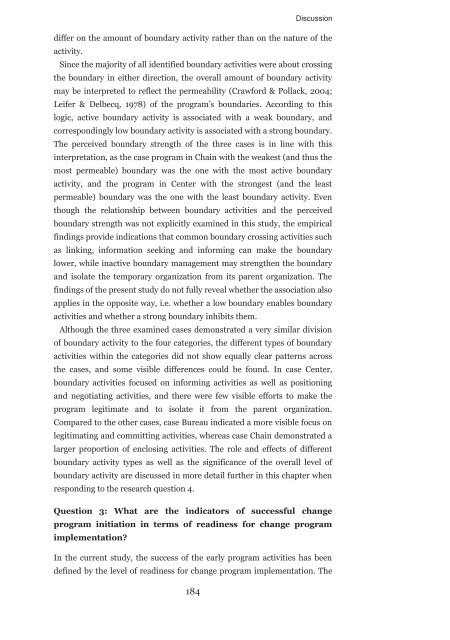Boundary activities and readiness for ... - Projekti-Instituutti
Boundary activities and readiness for ... - Projekti-Instituutti
Boundary activities and readiness for ... - Projekti-Instituutti
You also want an ePaper? Increase the reach of your titles
YUMPU automatically turns print PDFs into web optimized ePapers that Google loves.
Discussion<br />
differ on the amount of boundary activity rather than on the nature of the<br />
activity.<br />
Since the majority of all identified boundary <strong>activities</strong> were about crossing<br />
the boundary in either direction, the overall amount of boundary activity<br />
may be interpreted to reflect the permeability (Craw<strong>for</strong>d & Pollack, 2004;<br />
Leifer & Delbecq, 1978) of the program’s boundaries. According to this<br />
logic, active boundary activity is associated with a weak boundary, <strong>and</strong><br />
correspondingly low boundary activity is associated with a strong boundary.<br />
The perceived boundary strength of the three cases is in line with this<br />
interpretation, as the case program in Chain with the weakest (<strong>and</strong> thus the<br />
most permeable) boundary was the one with the most active boundary<br />
activity, <strong>and</strong> the program in Center with the strongest (<strong>and</strong> the least<br />
permeable) boundary was the one with the least boundary activity. Even<br />
though the relationship between boundary <strong>activities</strong> <strong>and</strong> the perceived<br />
boundary strength was not explicitly examined in this study, the empirical<br />
findings provide indications that common boundary crossing <strong>activities</strong> such<br />
as linking, in<strong>for</strong>mation seeking <strong>and</strong> in<strong>for</strong>ming can make the boundary<br />
lower, while inactive boundary management may strengthen the boundary<br />
<strong>and</strong> isolate the temporary organization from its parent organization. The<br />
findings of the present study do not fully reveal whether the association also<br />
applies in the opposite way, i.e. whether a low boundary enables boundary<br />
<strong>activities</strong> <strong>and</strong> whether a strong boundary inhibits them.<br />
Although the three examined cases demonstrated a very similar division<br />
of boundary activity to the four categories, the different types of boundary<br />
<strong>activities</strong> within the categories did not show equally clear patterns across<br />
the cases, <strong>and</strong> some visible differences could be found. In case Center,<br />
boundary <strong>activities</strong> focused on in<strong>for</strong>ming <strong>activities</strong> as well as positioning<br />
<strong>and</strong> negotiating <strong>activities</strong>, <strong>and</strong> there were few visible ef<strong>for</strong>ts to make the<br />
program legitimate <strong>and</strong> to isolate it from the parent organization.<br />
Compared to the other cases, case Bureau indicated a more visible focus on<br />
legitimating <strong>and</strong> committing <strong>activities</strong>, whereas case Chain demonstrated a<br />
larger proportion of enclosing <strong>activities</strong>. The role <strong>and</strong> effects of different<br />
boundary activity types as well as the significance of the overall level of<br />
boundary activity are discussed in more detail further in this chapter when<br />
responding to the research question 4.<br />
Question 3: What are the indicators of successful change<br />
program initiation in terms of <strong>readiness</strong> <strong>for</strong> change program<br />
implementation?<br />
In the current study, the success of the early program <strong>activities</strong> has been<br />
defined by the level of <strong>readiness</strong> <strong>for</strong> change program implementation. The<br />
184









